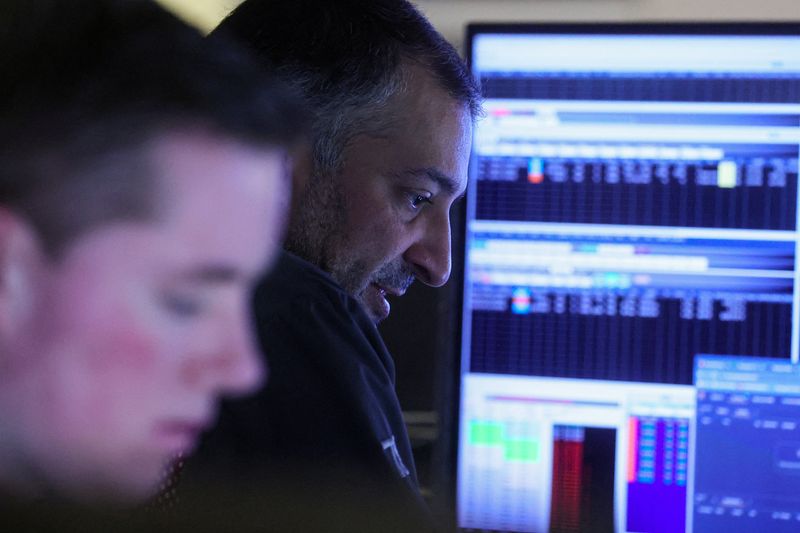By David Randall
NEW YORK (Reuters) -A resilient U.S. economy and expectations of a nearing peak in the Federal Reserve’s monetary policy tightening cycle are emboldening stock investors, even as worries persist over rising valuations and the potential for inflation to rebound.
The S&P 500 is up nearly 19% this year after gaining around 1% in the past week. It has risen nearly 10 percentage points since June 1, over which time the U.S. government avoided a debt ceiling default and consumer prices cooled, while growth stayed resilient.
One key factor driving stocks higher has been the view that the economy is moving towards a so-called Goldilocks scenario of ebbing consumer prices and strong growth that many believe is a healthy backdrop for stocks.
That view gained further traction in the past week, when Chair Jerome Powell said the central bank's staff no longer forecasts a U.S. recession and that inflation had a shot of returning to its 2% target without high levels of job losses.
Policymakers raised rates by another 25 basis points to their highest level since 2007 at the central bank's July 26 meeting and left the door open to another increase in September.
"The market has fully accepted the narrative that it wanted, which is Goldilocks. Until we see some set of data that scares them it's hard to see how that changes," said Bob Kalman, senior portfolio manager at Miramar Capital.
At the same time, investors believe the Fed is unlikely to deliver much more of the monetary policy tightening that shook markets last year. Futures markets on Friday priced a nearly 73% chance that rates don’t rise above current levels through the end of the year, according to CME’s FedWatch tool, up from 24% a month ago.
A test of the economy comes next week, when the U.S. reports employment numbers for July. While comparatively strong employment data has been a driver of this year’s stock rally, signs that the economy is growing at too rapid a pace could spark worries that the Fed will need to raise rates more than expected.
"For markets to continue to trade higher, the soft landing must be a soft landing, not a reacceleration, because if housing and consumer spending accelerate from here, the Fed will have to raise rates a lot more," wrote Torsten Slok, chief economist at Apollo Global Management (NYSE:APO).
Kalman, of Miramar Capital, believes there’s a growing chance the Fed may need to raise rates beyond their current 5.50% threshold and hold them there for longer than expected, an outcome he worries could dampen the economy and hurt risk assets.
"It's a 50-50 chance that we'll get Goldilocks or we'll get a stronger downturn," he said.
Many are also assessing the durability of a rally in tech stocks, which has been fueled in part by excitement over developments in artificial intelligence. The tech-heavy Nasdaq 100 is up nearly 44% year-to-date, while the S&P 500 information technology sector has gained nearly 46%.
Optimistic forecasts from Meta Platforms and results from Alphabet (NASDAQ:GOOGL) earlier this week bolstered the case for those who believe megacaps’ lofty valuations are justified. Some smaller companies have delivered as well, with shares of streaming device maker Roku (NASDAQ:ROKU) Inc soaring on Friday after it gave an upbeat quarterly revenue forecast.
Still, some investors have been looking outside of tech stocks for further gains, wary of rising valuations. The S&P 500 tech sector now trades at 28.2 times forward earnings, from 19.6 at the start of the year.
Burns McKinney, senior portfolio manager at NJF Investment Group, owns shares of Apple (NASDAQ:AAPL) and Microsoft (NASDAQ:MSFT) but has been adding to dividend-paying positions in healthcare, financials, and energy in anticipation that megacap names start to falter.
For megacap stocks, "the risk-reward is not as good as it was a quarter ago," he said.
Others believe the rally in equities is due for a pause. Randy Frederick, managing director of trading and derivatives for the Schwab Center for Financial Research, said he wouldn't be surprised to see the S&P 500 fall 5% or more in the next month or two as investors take profits on recent gains.Yet he also believes stocks are in the "early stages" of their recovery after falling into a bear market last year. "There’s always a concern with too much optimism, but longer term a sort of consolidation here speaks to a positive market going out," he said.
